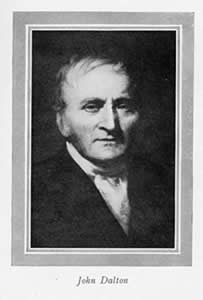John Dalton (1766)

Source: Wikimedia Commons, author unkown (Public Domain)
John Dalton was born in England in 1766, ten years before the U.S. Declaration of Independence was signed. His family lived in a small thatched cottage. As a small child, John worked in the fields with his older brother, and helped his father in the shop where they wove cloth. Although they had enough to eat, they were poor. Most poor boys at that time received no education, but John was lucky to attend a nearby school. In 1766, only about one out of every 200 people could read.
John was a good student and loved learning. His teachers encouraged him to study many things. When he was twelve, he opened his first school in a nearby town, but there was very little money. He had to close his school and work in his uncle's fields.
Three years later, he joined his older brother and a friend to run a school in Kendall, England. They taught English, Latin, Greek, French, and 21 math and science subjects. John studied the weather and the nature around him. He collected butterflies, snails, mites, and maggots. He measured his intake of food and compared it to his production of waste. He discovered he was color-blind and studied that, too.
In 1793, John moved to Manchester as a tutor at New College, and began observing the behavior of gases. He began to think about different elements and how they are made. He had a theory that each element is made up of identical atoms and that all elements are different because they are each made of different atoms. He thought that each element had a different weight, because it was made of different atoms.
In 1808, Dalton published a book, A New System of Chemical Philosophy, which listed the atomic weights of many known elements. His weights were not all accurate, but they formed the basis for the modern periodic table. Not everyone accepted Dalton's theory of atomic structure at the time, however. He had to defend his theory with more research.
When John Dalton died in 1844, he was buried with honors in England. More than 400,000 people viewed his body as it lay in state. As his final experiment, he asked that an autopsy be performed to find out the cause of his color-blindness. He proved that it was not caused by a problem with his eyes, but with his perception-the way his brain worked. Even in death, he helped expand scientific knowledge.
Today, scientists everywhere accept Dalton's theory of atomic structure. A simple country boy showed the world a new way of thinking about the universe and how it is made.


